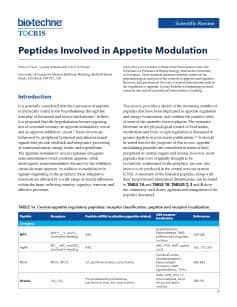Calcitonin and Related Receptors
Calcitonin and related receptors are a family of G-protein-coupled receptors that comprises eight subtypes; CT, AMY1, AMY2, AMY3, CALCR, CGRP, AM1 and AM2. The main function of CT receptors is to inhibit bone reabsorption and enhance calcium excretion by the kidneys.
Calcitonin and Related Receptor Agonists |
|
|---|---|
| Cat. No. | 产品名称/活性 |
| 3418 | Amylin |
| Endogenous peptide agonist for amylin, calcitonin, CGRP and adrenomedullin receptors | |
| 6031 | Calcitonin (human) |
| Endogenous calcitonin agonist; inhibits bone resorption | |
| 1159 | Calcitonin (salmon) |
| Affects bone formation and resorption | |
| 3012 | α-CGRP (human) |
| CGRP agonist | |
| 1161 | CGRP (rat) |
| Potent vasodilator | |
| 5031 | Pramlintide |
| Synthetic version of amylin (Cat. No. 3418) | |
| 2550 | SUN-B 8155 |
| Non-peptide calcitonin agonist | |
Calcitonin and Related Receptor Antagonists |
|
| Cat. No. | 产品名称/活性 |
| 3419 | AC 187 |
| Potent and selective amylin antagonist | |
| 4561 | BIBN 4096 |
| Potent and selective CGRP antagonist | |
| 1181 | CGRP 8-37 (human) |
| CGRP antagonist | |
| 1169 | CGRP 8-37 (rat) |
| CGRP antagonist | |
Calcitonin and related receptors are a family of G-protein-coupled receptors that comprises eight subtypes; CT, AMY1, AMY2, AMY3, CALCR, CGRP, AM1 and AM2. The receptors have a wide biological distribution; high concentrations are found in the brain, lung, liver, heart and spleen with lower expression levels present in the testes, gastrointestinal tract and thyroid.
The main function of CT receptors is to inhibit bone reabsorption and enhance calcium excretion by the kidneys. AMY receptors are heterodimers of the CT receptor and receptor activating modifying proteins (RAMP) 1-3, which have been implicated in type II diabetes pathology. The CALCRL receptor alone is non-functioning, but forms heterodimers with RAMPs to form the CGRP (CALCRL with RAMP1), AM1 (CALCRL with RAMP2) and AM2 (CALCRL with RAMP3) receptors. Their main function is inducing vasodilation, which causes hypotension. The CGRP receptor has also recently been implicated in the pathogenesis of migraine.
External sources of pharmacological information for Calcitonin and Related Receptors :
Literature for Calcitonin and Related Receptors
Tocris offers the following scientific literature for Calcitonin and Related Receptors to showcase our products. We invite you to request* your copy today!
*Please note that Tocris will only send literature to established scientific business / institute addresses.
Peptides Involved in Appetite Modulation Scientific Review
Written by Sonia Tucci, Lynsay Kobelis and Tim Kirkham, this review provides a synopsis of the increasing number of peptides that have been implicated in appetite regulation and energy homeostasis; putative roles of the major peptides are outlined and compounds available from Tocris are listed.
Calcitonin and Related Receptors Gene Data
| Gene | Species | Gene Symbol | Gene Accession No. | Protein Accession No. |
|---|---|---|---|---|
| CT | Human | CALCR | NM_001742 | P30988 |
| Mouse | Calcr | NM_007588 | Q60755 | |
| Rat | Calcr | NM_053816 | P32214 | |
| CALCRL | Human | CALCRL | NM_005795 | Q16602 |
| Mouse | Calcrl | NM_018782 | Q9R1W5 | |
| Rat | Calcrl | NM_012717 | Q63118 | |
| RAMP1 | Human | RAMP1 | NM_005855 | O60894 |
| Mouse | Ramp1 | NM_016894 | Q9WTJ5 | |
| Rat | Ramp1 | NM_031645 | Q9JJ74 | |
| RAMP2 | Human | RAMP2 | NM_005854 | O60895 |
| Mouse | Ramp2 | NM_019444 | Q9WUP0 | |
| Rat | Ramp2 | NM_031646 | Q9JHJ1 | |
| RAMP3 | Human | RAMP3 | NM_005856 | O60896 |
| Mouse | Ramp3 | NM_019511 | Q9WUP1 | |
| Rat | Ramp3 | NM_020100 | Q9JJ73 |
CT and CALCRL form heterodimers with RAMP1-3, forming additional calcitonin related receptors; AMY1, AMY2, AMY3, CGRP, AM1 and AM2. (AMY1 = CT + RAMP1, AMY2 = CT + RAMP2, AMY3 = CT + RAMP3, CGRP = CALCRL + RAMP1, AM1 = CALCRL + RAMP2, AM2 = CALCRL + RAMP3)
